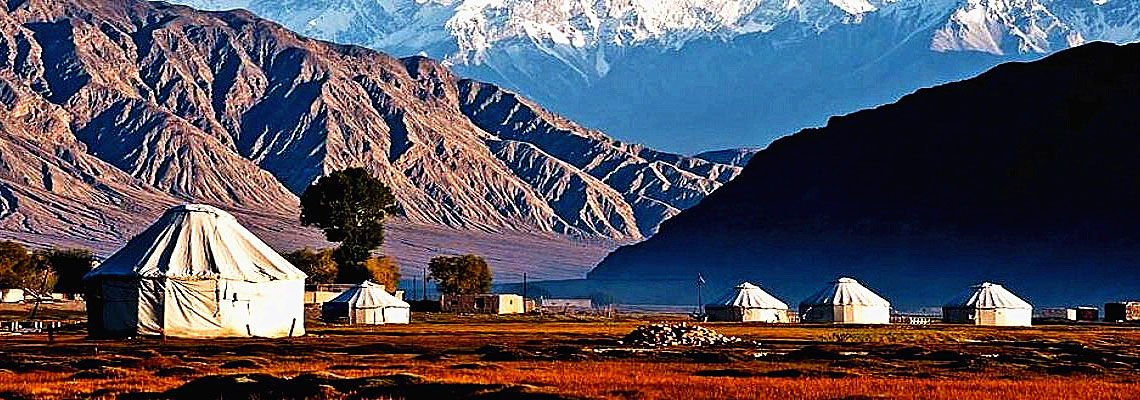
Day 1
UrumqiWe will meet you at the airport, transfer you to the hotel and check you in. Your exciting tour will begin the next day.
Day 2
Urumqi-
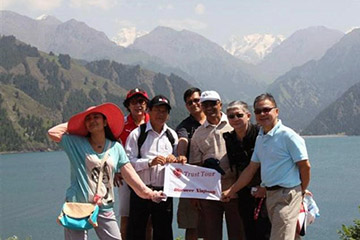
- Heavenly Lake
Erdaoqiao & International Bazaar: Here you will find a bustling market filled with fruits, clothing, crafts, knives, carpets, and almost anything that you can imagine. This is the largest bazaar in Urumqi, and is a place most welcomed by tourists, especially the ladies who will find they can buy some traditional Yugur cosmetics. On Sunday, there are more stalls and more goods to buy than any other day. The old streets around the bazaar are particularly worth seeing.
Heavenly Lake: High up in the Heavenly Mountain, or Tianshan, the Heavenly Lake is a long and narrow gourd-shaped moraine lake, 3400 meters long, about 1500 meters wide, 105 meters at the deepest point, with an average depth of 40 meters, covering an area of about 5.9 square kilometers. There are eight beautiful scenic spots in the lake area. These are “A Ray of Stone Gate”, “Dragon's Pool and Green Moon”, “Magic Needle for Guarding the See”, “Three Stones Bearing the Sky”, “the Snowcapped Southern Mountain”, “Pine Billows in Western Mountain”, “the Hanging Waterfall”, and the “Sea Peak's Sunrise”.
Day 3
Urumqi-
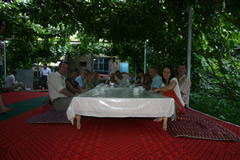
- Local Uyger Family
Tuyoq Valley: This is a 12 km long primitive Uighur agricultural valley about 70 km from Turpan, with vineyards and fields in the northern and southern valleys and a narrow ravine that connects them. It is a Muslim religious pilgrimage site. The southern mouth of the valley has big Uighur mosques older than the Sugong Minaret and a cave thought by many to be described in the Koran. About a kilometer from the cave shrine is a group of grottoes that have some Buddhist and Nestorian artwork. These grottoes are said to date from the West Jin Dynasty (265AD-316AD), and are considered to be the earliest in Turpan. Most of the murals are damaged. Fortunately, 10 of the grottoes still have some of the preserved murals. These precious murals are very unique in style.
Bezklik Grottoes:“Bezeklik”means “a place with beautiful decoration”. There are 83 numbered caves; among them 40 preserved murals totaling 1200 square meters. These caves are first excavated in Qu`s Gaochang period.
Local Uyger Family:Turpan is a kingdom of Grapes, all the local Uygur families plant the grapes at the back of their house. Local Urger family visiting is a special experience for you to know their lifestyle in the fireland.
The Flaming Mountain:is a legendary mountain, running from Shanshan County on west, 98 kilometers in length and 9 kilometers across, with a relative height of 500 meters and the highest peak 831.7 meters.
Day 4
Turpan-

- Karez Irrigation System
Visit the remarkable Karez Well System, Sugong Minaret,Jiaohe Ancient City . Afternoon drive back to Urumqi.
Karez Irrigation System,The Karez System is a unique irrigation system in Turpan, which, taking advantage of the slopes, draws the underground water to flow by itself to irrigate farmland. It consists of four parts: vertical wells, underground channels, ground canals and small reservoirs
Sugong Minaret was built in the 41st year of the Qianlong period of the Qing Dynasty,It is an embodiment of the ancient architectural arts of the Uygur nationality. The tower is 37 meters high and 10 meters in diameter at the base. The body of the tower is cylindroid in shape, built with bricks arranged in various symmetrical patterns.
Jiaohe Ruins :is located on a mesa in willow leaf shape between the Yarnaz River valleys 10 kilometers to the west of Turpan City. running from northwest to southeast, 1760 meters long and 300 meters across at the widest part. The city includes city gates, streets and lanes, government office, temples, domestic houses, cave houses, wells, and an underground temple.
Day 5
Urumqi-
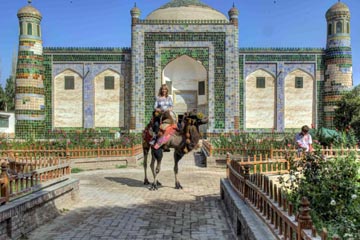
- Id Kah Mosque
Sunday Bazaar (livestock Market)Streets near this big market are choked on Sundays with farmers and buyers arriving by donkey cart, truck, bicycle, horseback, ute, motorbike or on foot, with their animals. It's loud, lively and cheerful as they arrive, eat breakfast, set up their animals and check out the action. Cattle, sheep (they definitely look different), goats, donkeys, horses have their own sections; sellers show their animals are "good eaters"(most go as livestock not meat) and the entire experience is fascinating and fun.
Apak Hoja Tomb This Mazar is the holiest place in Xinjiang and an architectural treasure Built in 1640 , it is reminiscent of the Central Asian artistic style of Samarkand or Isfahan. A handsome blue-and-white tiled gate leads into the compound, which includes a small religious school and the Abakh Khoja family tomb. The latter is domed and faced with muti - colored tiles.
Id Kah Mosque It is the large Mosque in China and most famous one in Xinjiang. The Mosque started to build in the mid of fifteenth century, and has gradually developed to the present size. Id K ah Mosque, with about 16800 square meters in area, consisting of Pray Hall, the Koran teaching Hall, The Corridor, the Arches and other buildings attaching to it.
Day 6
Irkeshtam Pass-
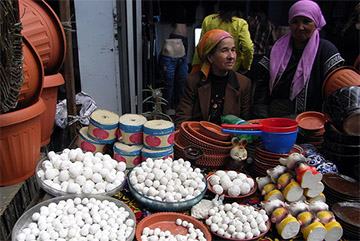
- Osh
Morning transfer to Chinese Kyrgyz Border Irkeshtan where you will be met by the Kyrgyz guide and then drive to Osh-is the second largest city in Kyrgyzstan, located in the Fergana Valley in the south of the country and often referred to as the "capital of the south". The city is at least 3,000 years old, and has served as the administrative center of Osh Province since 1939. The city has an ethnically mixed population of about 255,800 (in 2012), comprising Kyrgyz,Uzbeks, Russians, Tajiks, and other smaller ethnic groups.
Day 7
Osh-
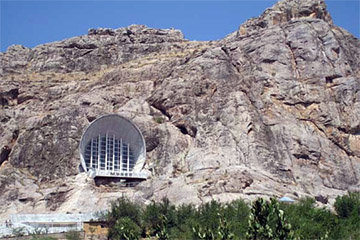
- The Terracotta Warriors
The Sulaiman Mountains:or the Kesai Mountains are a major geological feature of eastern and southeastern Afghanistan (Zabul, most of Loya Paktia and northeastern Kandahar), South Waziristan, most of the northern Balochistan province and some of the southwestern Punjab province of Pakistan. The Sulaiman Mountains form the eastern edge of the Iranian plateau where the Indus River separates it from the Indian Subcontinent. Bordering the Sulaiman Range to the north are the arid highlands of the Hindu Kush, where more than 50 percent of the lands lie above 2,000 meter.
Day 8
Ferghana-

- Alisher Navaiy Theatre Square
After breakfast drive to Tashkent Visit Silk Factory(Margilan)and Khan's Palace(Kokand) en route.upon arrival visit the enter of the city when we can see Amir Temur Square, Independence Square and Alisher Navaiy Theatre Square.
Day 9
Tashkent-
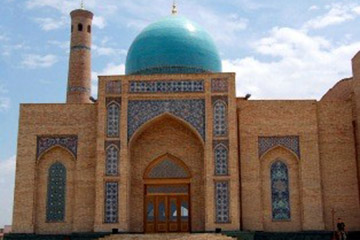
- Kaffal ash-Shoshiy Mausoleum
You will visit a wonderful complex Khasti Imamlocated in the old part of the city which had being the biggest center of Islamic culture in Uzbekistan during thousand years. You will also have an opportunity to visit local bazaar Chorsu. This bazaar is one of the biggest and popular one in the capital. Under seven domes covered with colored ceramic piles there are pavilions where farmers sell products of own production. Here you can feel aromas of different eastern spices, vegetables and fruits.You will have some time for shopping. Also, visit Kaffal ash-Shoshiy Mausoleum, Kukaldash, Barak khan and Abulqosim madrasas.Besides eastern atmosphere, Tashkent also has elements of modern city.
.
Day 10
Khiva-
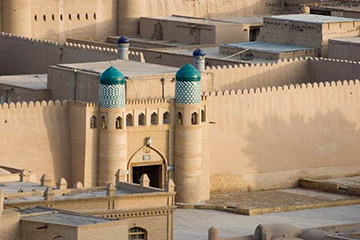
- Old Fortress Ark
After breakfast start panoramic excursion along Khiva – one of the cities of the Great Silk Road which is well kept. Previous capital city of Khiva khanate of 17th century even today keeps that mysterious atmosphere of the ancient eastern city. It is especially can be felt in the old part Ichan-Kala where a lot of historical-architectural monuments are situated. While walking in the labyrinth of narrow streets you will nearly find yourself in another epoch with palaces decorated with mosaic, mausoleums, mosques and madrasahs built of clay bricks. There are many columns and entrance doors around wonderfully and richly decorated by wooden carving – the art which was popular in Khiva from ancient times. Especially you will be impressed by the Old Fortress Ark, Tash Hovli palace, Djuma mosque (Friday mosque) and Pakhlavan Mahmud Mausoleum. From far away you can recognize silhouette of Islam Khodja Minaret. Many architectural buildings of Ichan-Kala city had been constructed at the period from the end of 18th century to the beginning of 19th century. Khiva is included into the list of world heritage of UNESCO.
Day 11
Khiva-

- Kyzyl Kum Desert
After breakfast drive to Bukhara through Kyzyl Kum Desert. Along the way we stop for some Refreshments and see how humans have survived over the centuries in this unforgiving landscape.
Day 12
Bukhara-
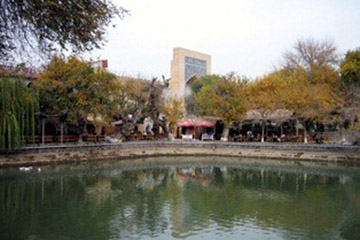
- Char Minar
Excursion along Bukhara: Chashmai-Ayub Mausoleum (14-19th cc.), Poyi-Kalon Complex (12-16th cc.), Miri-Arab Madrasah (16th c.), Lyabi-Hauz Complex (16-17th cc.), Samanids Mausoleum (9-10th cc.), Nadir Devonbegi Madrasah (1622), Ark Citadel (6-7th cc.) – this is citadel from which ancient Bukhara had begun, Chor-Minor Minarets (18th c.), Sitorai Mokhi-Khosa – “The palace of the Moon and Stars” – summer residence of the last Bukharian Emir (19th c.).
Day 13
Bukhara-
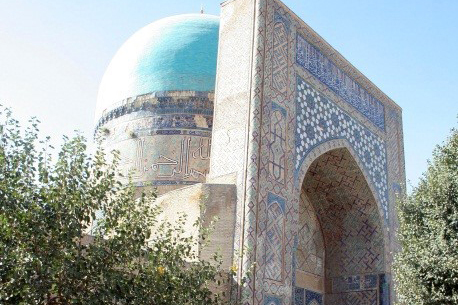
- Djakhangir Mausoleum
Excursion along the city: Ruins of Ak Saray palace(1380-1404), Dorut-tilyavat Ensemble (14-15th cc.), Dorus-siadat Ensemble (14th c.), Amir Temur Monument, Kok Gumbaz Mosque (1435), Djami Mosque (1915), Djakhangir Mausoleum (14th c.), Chor-su trade Dome.We continue later to Samarkand.On arrival we’ll visit the Old Bazaars for which this exotic city is famous.
Day 14
Samarkand-
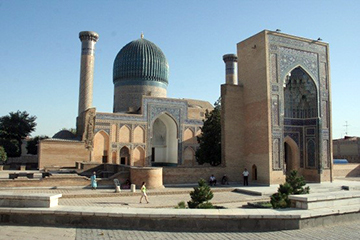
- Guri-Emir Mausoleum
Samarkand is one of the ancient cities in the world, contemporary of Athens, Roma and Babylon. Samarkand is more than 2500-years old. On the East Samarkand calls as “precious pearl”, appearance of the earth”. Guri-Emir Mausoleum and burial vault of Timurids dynasty from far away remembers a blue tulip with closed turquoise petals. Registan Square is a heart of Samarkand. The square appeared many times before the Mongols invasion (18th century) as a place of city craftsmen and tradesmen crowding. The word Registan means “place on the sand”.You will also visit Bibi-Khanum Mosque (15th c.) and Shakhi-Zinda Architectural Ensemble (10-19th cc.) that consists of several mausoleums.Afternoon visit the Afrosiab Museum.
Day 15
Samarkand-
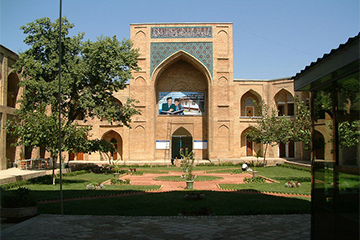
- Islamic schools
In the morning we drive to Tashkent. Visiting Mosques and Madrassas (Islamic schools) Housing Craft Workshops, Kukeldash Medressa- is located on a high hill in the area of Chorsu square. The builder of the madrasah was a vezir of the Tashkent khans (1551-1575), called Kukeldash ("the foster-brother of the khan"). The madrasah has a traditional composition: an extensive court yard, built on khudjras, with darskhana and a mosque in the corners.History Museum of Uzbekistan and the Museum of Fine Arts.
Day 16
TashkentAfter breakfast rip will end with airport transfer
| Travel in party of |
Superior Class ★★★★★ |
Deluxe Class ★★★★ |
Tourist Class ★★★ |
| 2-5 persons | N | On Enquiry | On Enquiry |
| 6-9 persons | N | On Enquiry | On Enquiry |
| 10 persons & above | N | On Enquiry | On Enquiry |
| Single room Supplement | N | On Enquiry | On Enquiry |
Service included:
√ Breakfast in the hotel
√ Personal Guide & Driver + Private car / van for Private Transfers & sightseeing
√ Hotels with breakfast(twin share bases) as listed in the itinerary .
√ Domestic flights or trains as listed in the itinerary
√ Airport Taxes: US$30for domestic,
√ Service Charge & Government Taxes .
√ Luggage Transfers between airports and hotels
√ Goverment letter for visa support
Service excluded:
* Personal expenses, tips to the guide and driver.
* Other activities such as boating, camel riding ect.

